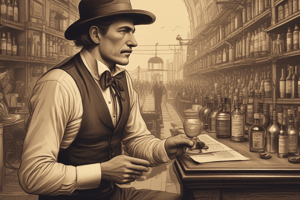Podcast
Questions and Answers
The American Temperance Movement advocated for the temperance of ______.
The American Temperance Movement advocated for the temperance of ______.
alcohol
Concerns about poverty, family violence, and public health fueled the movement's ______.
Concerns about poverty, family violence, and public health fueled the movement's ______.
motivations
Organizations like the American Temperance Society played critical roles in promoting the ______.
Organizations like the American Temperance Society played critical roles in promoting the ______.
movement
Neal Dow was a prominent figure and leading voice for ______.
Neal Dow was a prominent figure and leading voice for ______.
The movement faced criticism for being overly ______ and infringing on individual liberties.
The movement faced criticism for being overly ______ and infringing on individual liberties.
The temperance movement intersected significantly with other reform movements such as abolitionism, women's suffrage, and the ______ movement.
The temperance movement intersected significantly with other reform movements such as abolitionism, women's suffrage, and the ______ movement.
The 18th Amendment, ratified in 1919, prohibited the production, sale, and transportation of ______ beverages in the US.
The 18th Amendment, ratified in 1919, prohibited the production, sale, and transportation of ______ beverages in the US.
The temperance movement had a lasting effect on societal attitudes towards alcohol and ______.
The temperance movement had a lasting effect on societal attitudes towards alcohol and ______.
The enforcement of temperance laws was often problematic, with varying degrees of ______.
The enforcement of temperance laws was often problematic, with varying degrees of ______.
Despite the movement's success, the 'dry' era also demonstrated the difficulties of implementing and maintaining widespread societal ______.
Despite the movement's success, the 'dry' era also demonstrated the difficulties of implementing and maintaining widespread societal ______.
Flashcards
American Temperance Movement
American Temperance Movement
A social and political movement advocating for the moderation or complete abstinence from alcohol.
Motivations of the Temperance Movement
Motivations of the Temperance Movement
The movement was driven by concerns about the social and economic consequences of excessive alcohol consumption, such as poverty, violence, and health issues.
Key Stages and Strategies of the Temperance Movement
Key Stages and Strategies of the Temperance Movement
Early stages focused on persuasion and education. Later stages adopted radical approaches like pushing for legal restrictions on alcohol production and sales.
Key Figures and Organizations of the Temperance Movement
Key Figures and Organizations of the Temperance Movement
Signup and view all the flashcards
Impact of the Temperance Movement
Impact of the Temperance Movement
Signup and view all the flashcards
Challenges to Temperance Enforcement
Challenges to Temperance Enforcement
Signup and view all the flashcards
Connections to Other Reform Movements
Connections to Other Reform Movements
Signup and view all the flashcards
Long-Term Impact on Society
Long-Term Impact on Society
Signup and view all the flashcards
Path to Prohibition
Path to Prohibition
Signup and view all the flashcards
The Dry Era
The Dry Era
Signup and view all the flashcards
Study Notes
Overview of the American Temperance Movement
- The American Temperance Movement was a social and political reform movement in the United States advocating for the temperance of alcohol.
- It spanned from the early 19th century to the early 20th century.
- Prominent figures and organizations played crucial roles in driving the movement forward.
Origins and Motivations
- The movement was fueled by concerns about the social and economic consequences of excessive alcohol consumption.
- These included poverty, family violence, crime, and public health issues.
- Religious and moral motivations were also significant factors.
- Various religious denominations championed the movement, recognizing alcohol as a moral failing.
Key Stages and Strategies
- Early stages focused on persuasion and education; emphasizing the moral harm of alcohol.
- Later, the movement adopted more radical approaches, including pushing for legislative restrictions on alcohol production and sales.
- Organizations like the American Temperance Society and the Washingtonians played critical roles in promoting the movement.
- Advocates employed public campaigns, rallies, and publications to reach a broad audience.
- These actions broadened the movement's goals and methods.
Key Figures and Organizations
- Members of the clergy played a prominent role, often inspiring members of the community to join.
- The movement gained support from various social classes and ethnic groups.
- Prominent figures included figures like Neal Dow, who became a leading voice for prohibition.
- The American Temperance Society (ATS) was one of the foremost organizations, coordinating efforts across the nation.
Impact and Legacy
- The movement led to widespread social changes and significant legislative actions.
- The impact was seen in reduced alcohol consumption in some communities and increased support for temperance-related laws over time.
- The movement laid the groundwork for the Prohibition era.
- The movement significantly influenced public health policies, promoting moderation and abstinence from alcohol.
- The movement had significant effects on social norms and attitudes towards alcohol consumption.
Challenges and Criticisms
- The movement faced opposition from those with vested interests in the alcohol industry.
- Some critics argued that the movement's approach was overly restrictive and infringed on individual liberties.
- Enforcement of temperance laws was often problematic, with varying degrees of success.
- The movement was not uniformly successful across all regions and demographic groups.
Relationship to Other Reform Movements
- The temperance movement intersected significantly with other reform movements of the era.
- These included abolitionism, women's suffrage, and the progressive movement.
- Many individuals and groups were actively involved in multiple reform endeavors.
- Shared concerns and goals linked these movements in promoting social and moral improvement throughout American society.
Lasting Impact on Societal Attitudes
- The temperance movement had a lasting effect on societal attitudes towards alcohol and health.
- The movement demonstrated the power of social activism to influence public policy and individual behavior.
- The legacy of the movement continues to be debated and analyzed by historians and social scientists.
- Its impact manifested not only in policy changes but in cultural norms regarding alcohol for generations.
Prohibition and the 18th Amendment
- The success/influence of the temperance movement helped pave the way for the 18th Amendment.
- The 18th Amendment, ratified in 1919, prohibited the production, sale, and transportation of alcoholic beverages in the US.
- The amendment reflected the movement's widespread influence and its desire for change.
- The "dry" era, despite the movement's success, also demonstrated the difficulties of implementing and maintaining widespread societal changes.
Studying That Suits You
Use AI to generate personalized quizzes and flashcards to suit your learning preferences.
Description
Explore the American Temperance Movement, a pivotal reform initiative that spanned from the 19th to early 20th century. This quiz delves into its origins, motivations, key figures, and the evolution of its strategies. Test your knowledge on how this movement impacted society and legislation regarding alcohol in the United States.




